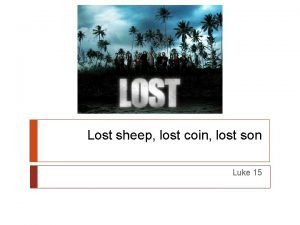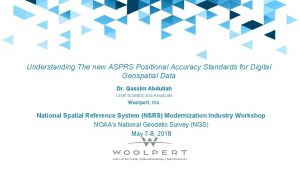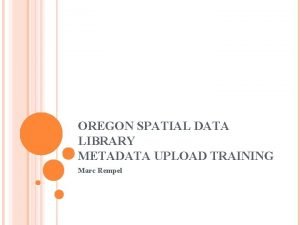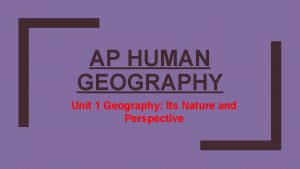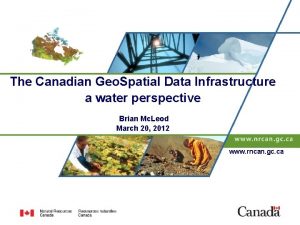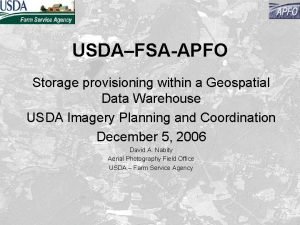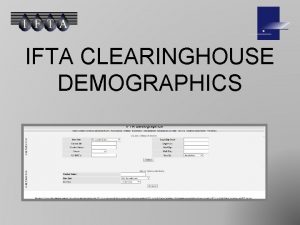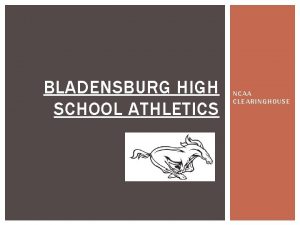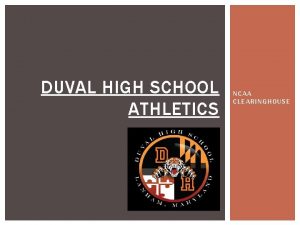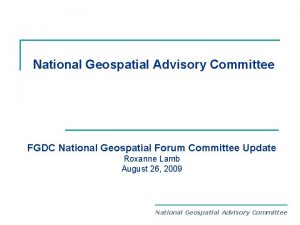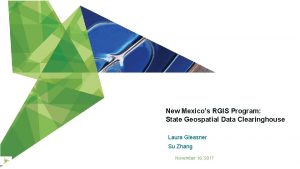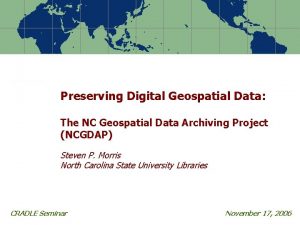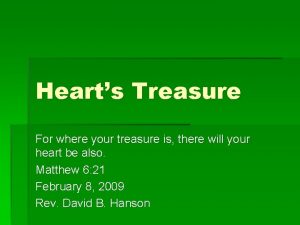Mining For Lost Treasure National Geospatial Data Clearinghouse

































- Slides: 33

Mining For Lost Treasure National Geospatial Data Clearinghouse Archibald Warnock U. S. Federal Geographic Data Committee A/WWW Enterprises

What is Clearinghouse? v A distributed service to locate geospatial data based on characteristics expressed in metadata v Clearinghouse allows a user to pose a query of all or a portion of the community in a single session v Like a spatial Alta. Vista

National Geospatial Data Clearinghouse v Distributed data producers and users. v Key components: – Data documentation (metadata) – Networking (Internet) – Serving, searching, and accessing software u Z 39. 50 Search and Retrieve Protocol u WWW - World Wide Web

Components of Clearinghouse v There are three functional areas that interact to create the Clearinghouse: – Metadata preparation and indexing – Metadata service – User Access via Gateway forms

Clearinghouse Method Metadata preparation Metadata validation/ staging Metadata publication User access

Clearinghouse Design v The Clearinghouse in its distributed form includes a registry of servers, several WWW -to-Z 39. 50 gateways, and many Z 39. 50 servers v A primary goal of Clearinghouse is to provide the ability to find spatial data throughout the entire community, not one site at a time

Essential Configuration Gateways Clearinghouse Sites Node Web Client FGDC Node

User downloads query form Gateways Clearinghouse Sites Node Web Client FGDC Node

User sends query to web server Gateways Clearinghouse Sites Node Web Client FGDC Node

Gateway passes query to Clearinghouse Servers Clearinghouse Sites Gateways Node Web Client FGDC Node

Gateway receives and collates “hits” Gateways Clearinghouse Sites Node Web Client FGDC Node

Client receives results summary as HTML Clearinghouse Sites Gateways Node Web Client FGDC Node

Client can request a specific metadata record for viewing Gateways Clearinghouse Sites Node Web Client FGDC Node

Node in More Detail Internet Z 39. 50 server Data Index/DB Metadata

Data v The most expensive investment for an organization v Created by many different organizations v To solve many different problems v Using many different methods and technologies

But. . . v Data are hard to find v Data are difficult to access v Data are hard to integrate v Data are not current v Data are undocumented v Data are incomplete

The uses of metadata Provides documentation of existing internal geospatial data resources within an organization (inventory) v Permits structured search and comparison of held spatial data by others (advertising) v Provides end-users with adequate information to take the data and use it in an appropriate context (liability) v

Metadata Solutions v Numerous software solutions available v Commercial and free-ware v Standalone, DB-linked, GIS-linked v Permit collection and structuring of FGDC- compatible metadata v Present metadata as HTML, XML, or text

GILS, Dublin Core and Others v v Dublin Core is a minimal (15 fields) generic metadata scheme for virtually any kind of document GILS represents a more detailed approach, including most of DC, providing greater interoperability GILS is less bibliographically oriented than (Z 39. 50) BIB 1 GILS is lightweight compared to GEO (FGDC) and EOS/CIP (which have specific functional requirements)

What Structured Metadata Means -1 v GILS - Fewer fields ü More documents ü More metadata records ü Skinnier metadata records ü Easier abstraction v FGDC - More fields ü Fewer documents ü Fewer metadata records ü Fatter metadata records ü Less abstraction GILS is a good, general compromise

What Structured Metadata Means - 2 v A Z 39. 50 profile as defines a language ü At some level, Z 39. 50 is a detail ü Protocols are about communication, profiles are about abstraction and GILS is about content ü Z 39. 50 guarantees that the user’s query can be unambiguously decoded - no guarantees about content ü We could implement the profile over any protocol - http, CORBA, etc. v Do we have to use Z 39. 50? ü No, but the abstraction is required ü Z 39. 50 already includes the abstraction model

How much metadata is enough? v Internal documentation for local use (local inventory) v Basic documentation for discovery of information holdings (catalog/search) v Detailed documentation to provide endusers with adequate information for re-use (asset management)

Server Solutions v Z 39. 50 Protocol is used v “GEO” Geospatial Metadata Profile is published for Z 39. 50 implementors to understand FGDC metadata structures v Supports search across numeric, text, date, and spatial extent and full-text v Freeware and commercial solutions

Gateway in more detail Nodes Web client Web Z 39. 50 server Gateway clients interface Web Gateway Case

User Interfaces v HTML-based forms hosted at Gateways are the primary access method v Java map-based interface from MEL allows more sophisticated search v Inclusion of search capabilities in GIS client software is possible

Who’s in Clearinghouse? v 109 Nodes (servers) online as of 3/1/99 – 28 Federal, national scope – 35 State/University state-wide scope – 28 International scope or location – 18 Local or Regional scope

US Federal Participation NOAA (10) v USGS (6) v FEMA (sampler) v NRCS climate and soils v CIESIN/EPA v CIESIN/NASA v DOT NTAD v National Park Service v Army Corps of Engineers v Tri-Services Center v National Wetlands Inventory v Census (sampler) v Minerals Management Service v

State Participation New York (2) v West Virginia v North Carolinav Washington v Wisconsin v Oklahoma v Wyoming (2) v Kansas v Florida v Texas v Montana (3) v Alabama v New Mexico v Vermont v Pennsylvania v Arizona v Georgia Illinois Minnesota Alaska California Delaware Nebraska (2) New Jersey

Regional/Local Participation v Olympic Peninsula, WA Mc. Kinley Co, NM v City of Santa Fe, NM v Greater Yellowstone v Helena NF v North Texas GIS v Ecological Reserves, KS v Research Planning v Sabine R Authority, TX v MIT/Mass Boston DOQs v Great Lakes EIS v San Francisco Bay v Eastern Sierra v S Florida Ecosystem v SW Natural Resources v

International Participation NOAA/Japan GOIN v South Africa (2) v ESA AVHRR sampler v GELOS, Italy v PAIGH, Mexico v S 57 Hydrography, Canada v NRL MEL v Africa DDS v Inter-American v

Planned or Funded Nodes Mt Desert Island, ME v SW Washington COG v NASA GCMD v CODEPLAN, Brazil v Iowa v Missouri v Kentucky v

Clearinghouse provides. . . v Discovery of spatial data v Distributed search worldwide v Uniform interface for spatial data searches v Advertising for your data holdings

For more information: Visit the FGDC website: http: //www. fgdc. gov Contact the Clearinghouse Coordinator, Doug Nebert (ddnebert@usgs. gov) or Archie Warnock (warnock@awcubed. com)
 Luke 15:11-35
Luke 15:11-35 Eck
Eck Mining multimedia databases
Mining multimedia databases Uheaa contact
Uheaa contact National student clearinghouse student tracker
National student clearinghouse student tracker Strip mining vs open pit mining
Strip mining vs open pit mining Mineral resources and mining chapter 13
Mineral resources and mining chapter 13 Difference between strip mining and open pit mining
Difference between strip mining and open pit mining Difference between text mining and web mining
Difference between text mining and web mining Asprs standards
Asprs standards Oregon geospatial data library
Oregon geospatial data library Remote sensing ap human geography
Remote sensing ap human geography Mit geospatial data center
Mit geospatial data center Canadian geospatial data infrastructure
Canadian geospatial data infrastructure Geospatial data definition ap human geography
Geospatial data definition ap human geography Gdw data warehouse
Gdw data warehouse Data reduction in data mining
Data reduction in data mining What is data mining and data warehousing
What is data mining and data warehousing What is missing data in data mining
What is missing data in data mining Concept hierarchy generation for nominal data
Concept hierarchy generation for nominal data Data reduction in data mining
Data reduction in data mining Data reduction in data mining
Data reduction in data mining Data cube technology in data mining
Data cube technology in data mining Data reduction in data mining
Data reduction in data mining Arsitektur data mining
Arsitektur data mining Perbedaan data warehouse dan data mining
Perbedaan data warehouse dan data mining Datamart olap
Datamart olap Descriptive mining of complex data objects
Descriptive mining of complex data objects Olap database
Olap database Noisy data in data mining
Noisy data in data mining Two tier architecture of data warehouse
Two tier architecture of data warehouse Markku roiha
Markku roiha Data compression in data mining
Data compression in data mining Introduction to data warehouse
Introduction to data warehouse
